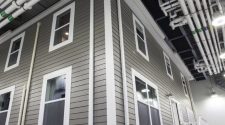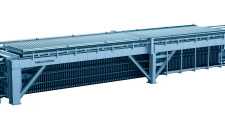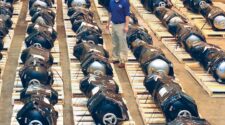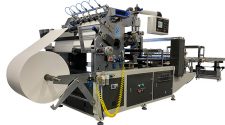Founders of this Award-Winning Start-up Stayed True to Mission and Proved Critics Wrong
When Dr. Serene Almomen, CEO of sensor-based monitoring systems leader Attune (formerly Senseware), and co-founder Dr. Julien Stamatakis first founded their company, they certainly had a vision for what their company would hopefully become, but today, Attune has made a name for itself by developing a unique air quality monitoring solution platform with 45 patents, that is causing industry experts to take notice. International Filtration News connected with Almomen to learn more about her ever-expanding company and the impact it is having on challenges within the air filtration space.
International Filtration News: What is your background that has led you to a fast-rising career in air filtration, being named in 2022 as one of Forbes’s top 50 women-led startups in the technology industry?
Serene Almomen: Every startup faces challenges and encounters obstacles in product development and go-to-market strategies. Our startup also needed to break through with minimal funding. It is well known that only about 2.3% of venture capital (VC) funding went to women-led startups. Undercapitalization has been a persistent foe, but it didn’t stop us from implementing our vision of a ground-breaking IoT platform solution.
My co-founder and I laughably admit that Attune was founded before we ever knew that the Internet of Things (IoT) was even a “thing.” Of course, VCs actively discouraged us from building a horizontal IoT platform. They were wrong. Billion-dollar companies now discard their own inferior solutions and adopt Attune’s modular IoT technology stack.
Funding shortfalls have been a classic “blessing in disguise.” We did not have the luxury of pursuing market initiatives that would not pay off; we had to fail fast and not waste resources. Our modular IoT technology gives us an advantage to do more with a lot less than our competitors. We can now outperform our peers in meeting the challenges of new markets with superior agility. Attune’s fast rise in the air filtration market is one example of our success.
IFN: Tell us about your air quality sensor product, and how it originated? What is the technology that makes your sensor work?
Almomen: Attune’s IAQ product line is an example of the power of our modular IoT technology. Many in the industry think that we are an IAQ company because of our leadership in the IAQ market. Our IoT solutions go far beyond IAQ, however, and include real-time solutions in energy metering/submetering, HVAC asset condition monitoring (ACM), and remote facility management.
Our IAQ-specific innovations came about because our customers asked us for a solution. The evolution of our IAQ product line (see Chart 1) shows Version 1 of our IAQ solution was created in 2014 with our standard wireless Node that integrated a temperature and humidity sensor. In 2016, a building engineer came to us with a need for a wireless solution to measure carbon dioxide (CO2). It only took a few weeks to integrate a CO2 sensor into our wireless hardware and a new product was born.
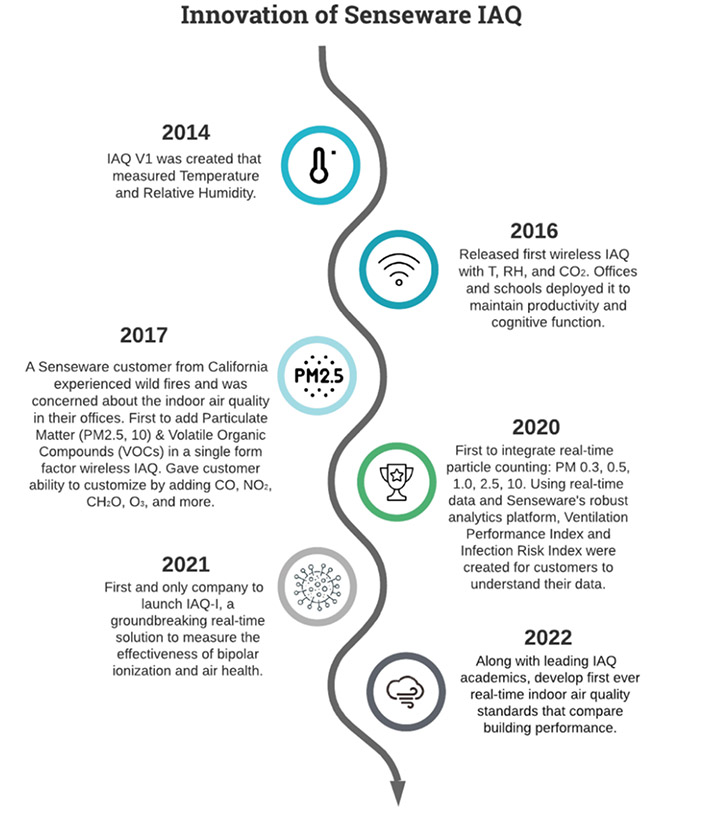
In 2017, we were asked for a solution to measure Particulate Matter (PM) due to the problem of wildfires in California. After a few weeks’ time, we were the first company to release a wireless IAQ device that measured Temperature, Humidity, CO2, PM, and Volatile Organic Compounds (VOCs) in a single enclosure. The sensors in this IAQ model configuration became relatively standard in the industry just last year (2022); Attune happened to have released it five years before most of the competition!
Our IAQ innovation didn’t stop there. In 2020, due to the COVID-19 pandemic, we integrated next-generation PM sensors that featured sub-micron particle sensing and released a proprietary Ventilation Performance Index and Infection Risk Index to aid the industry in re-populating public spaces. Sub-micron PM sensors are close to cleanroom grade PM sensors. The integration of a sub-micron PM sensor has proven to be particularly valuable in the air filtration industry because it enables facility managers (FMs) to assess the sub-micron particle filtering efficacy of MERV 13-15 air filters.
As the old adage goes, “You can’t manage what you can’t measure.” That theme led to our 2021 development of the IAQ-I product, which integrated an ion sensor to determine the efficacy of NeedlePoint Bipolar Ionization (NPBI) systems. The official CDC position of NPBI is as follows:
“Consumers should request efficacy performance data that quantitatively demonstrate a clear protective benefit under conditions consistent with those for which the consumer is intending to apply the technology.”
Attune has developed a leadership position in IAQ because we have applied our innovative technology to address real-world problems faced by the industry.
Funding shortfalls have been a classic “blessing in disguise.” We did not have the luxury of pursuing market initiatives that would not pay off; we had to fail fast and not waste resources. Our modular IoT technology gives us an advantage to do more with a lot less than our competitors.
IFN: What is the science behind your technology? How was it developed and tested? How long did it take to develop?
Almomen: An interesting fact about our company history is that our technology is grounded in Attune co-founder Julien Stamatakis’ use of accelerometer sensors to help doctors objectively diagnose the severity levels of Parkinson’s disease patients. He faced a problem, however, in that the integration of additional sensors (e.g., gyroscope) to improve the Parkinson’s diagnosis would take too long, making it impractical.
We solved that problem and created a novel IoT architecture based on modular industrial design principles. This new architecture enabled the integration of next-generation sensors on the fly. Key benefits of Attune’s modular IoT architecture is the ability to greatly increase the number of product variations, while drastically reducing the time to market.
The architectural flexibility we developed was groundbreaking. The no-code sensor reconfiguration of IoT hardware enabled us to target under-performing buildings in desperate need of real-time sensor data. The pivot was natural, as we recognized the opportunity of using technology originally designed to diagnose the health of a human body to now diagnose the health of buildings.
IFN: As an entrepreneur in the air filtration space, what challenges have you overcome to bring your product to market?
Almomen: One of the primary challenges that we faced was skepticism, both in the capital markets and the CRE industry.
VCs actively discouraged us from pursuing a horizontal IoT platform strategy. Instead, they wanted us to focus on going to market with a purpose-built, vertical product. For years, we heard the same opinion from the investment community. It was humorous to see the VC community do a “180” a few years later, admitting that they hadn’t seen much success with IoT business models built around a vertical product strategy.
I’m really glad we didn’t take their advice. If we hadn’t stuck to our beliefs and built our modular IoT platform architecture, we would have been unable to develop the products we have today to meet the challenges in the IAQ and air filtration space.
The CRE industry was also skeptical, but surprisingly more adaptable and pragmatic than the investment community. When we first began applying our technology to the CRE market, we were told that the market is historically very slow to embrace change. While some rightly questioned whether wireless IoT products would “work,” many building engineers were open to the idea because they had real problems to solve in a building. Today, the value proposition of wireless IoT products has largely been accepted. They need solutions to meet their needs. The CRE fact that “one size does not fit all” has further validated our pursuit of a horizontal IoT platform strategy over a purpose-built, vertical product strategy.
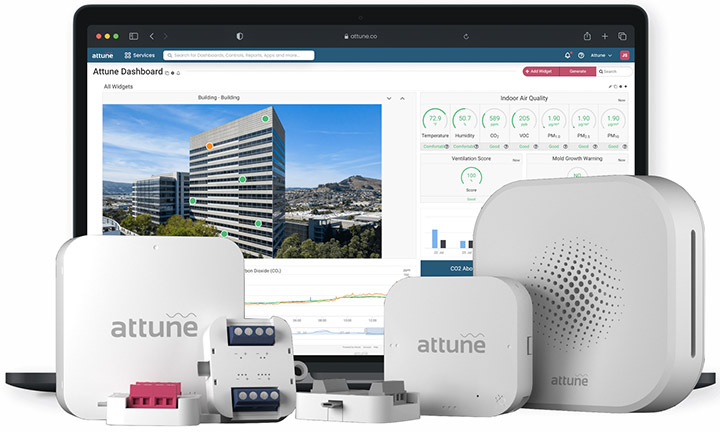
IFN: What challenges did you and co-founder Dr. Julien Stamatakis overcome in product development in general?
Almomen: The major hurdle we faced was committing to build our horizontal IoT platform technology. While we did a market pivot early on from focusing on the medical industry to focusing on the CRE industry, we have had no such pivots from a technology standpoint. Our technology has stayed true to our original vision we had since the founding of the company.
One of the reasons I believe we haven’t pivoted is because we had a focus on solving a practical technology problem in creating a Universal Sensor Interface that enables us to rapidly connect to new sensors without redevelopment. We weren’t trying to solve a sales and marketing problem, which will shift like the wind.
One of our company values is that “Ambiguity Fears Us.” Can’t find a solution? No worries, we’ll invent one. Innovation is at the core of Attune. Many tout their own innovation, but we understand that innovation doesn’t happen without hard work and a willingness to get it done. The very ethos underpinning the company demands engineering future-proof solutions. Attune’s innovative Universal Sensor Interface reflects that vision in providing a sensor framework that enables rapid addition of future sensor functionality.
IFN: Tell us about your company’s work during the coronavirus, which caught the attention of national news – how did that come about?
Almomen: Like everyone else, we were also hit hard by the realities of COVID-19. Many of our customers in the CRE industry were coming to grips with the changes forced upon them by the pandemic. We knew that isolation and containment was a response, not an answer. As engineers and data scientists we proceeded to look for answers on how IoT environmental sensing could be used to reopen spaces.
The airborne transmission of COVID-19 pathogens led to our investigation of how real-time sensing could be used to assess the health of interior spaces and to discover the efficacy of ventilation systems used to mitigate airborne transmission of COVID-19. While the public had accepted a measure of responsibility by wearing masks, we also recognized that the CRE industry bore some responsibility in doing what they reasonably could to mitigate COVID-19 transmission in their spaces. We wanted to give them various tools to do so.
Sensor technology evolves rapidly, and our modular IoT platform is particularly suited to integrating with sensors as soon as they are released from development labs. We did manage to integrate our platform with a sensor that could detect the actual COVID-19 pathogen, but the price tag of those COVID-19 sensors (~40k-50k) made wide scale deployments questionable.
Our previous work in IAQ was also quite beneficial. We developed a proprietary Ventilation Performance
Index and Infection Risk Index based on the analysis of real-time IAQ measurements of the changing levels of airborne pollutants. This enables FMs to assess actual ventilation system performance.
Additionally, we integrated with next-generation sub-micron PM sensors to assess the performance of MERV 13-15 sensors, which were designed to filter sub-micron particles with higher efficiency. Droplets of sub-micron particle sizes were known to carry the COVID-19 virus pathogen.
The major change that has happened since COVID is awareness about what they might be breathing. For the last couple of years people who enter any building (e.g., office, school, store, hotel, etc.) have been conditioned to question the impact of the environment on their well-being. FMs can’t guarantee that no one will get sick when entering their facility, but they can demonstrate to the public that they are taking responsibility for their space. We give them the tools to do so because “you can’t manage what you can’t measure.”
IFN: What was the motivation to rebrand the company from Senseware to Attune?
Almomen: The rebrand reflects the company’s evolution of success in the marketplace, having established what we believe is the industry’s most comprehensive and flexible IoT sensor platform to now partnering with our customers in delivering needed real-time data for digital transformation.
Just as we have outgrown our startup basement workspace, so too has Senseware outgrown its name. We have come a long way. More than our ability to rapidly integrate sensors via our modular IoT hardware platform, we have become known for our ability to connect customers to the critical data they need, all on one platform. We have rebranded as Attune because we are a platform that’s attuned to all our customers’ needs, configured to their specifications. We continue to help our customers tune in to the data and achieve new levels of awareness of the environments and spaces we occupy. See the unseen. Know the unknown.
The air filtration industry is firmly taking up the Clean Air in Buildings Challenge as they increasingly implement MERV 13-15 air filters. What they need is real-time sub-micron PM data to determine when those air filters are dirty and need to be changed.
IFN: Can you explain the impact of the Biden-Harris Administration’s Air Quality Summit, as well as the administration’s Clean Air initiatives?
Almomen: The primary impact is awareness. Indoor air quality is increasingly a public concern because we all wonder what we might be breathing.
The Clean Air in Buildings Challenge is a step in the right direction because it points to a glaring hole in the technology infrastructure of buildings world-wide. It is a fact that many of the most advanced Class A office buildings that have been commissioned last year have little to no real-time IAQ monitoring as part of the Building Management System (BMS).
We call those buildings functionally obsolete because while they are technologically new, they are not designed with the functions you need, i.e., performing real-time measurements of airborne pollutants such as PM, VOCs, ozone, carbon monoxide, formaldehyde, etc.
Digitization of buildings is at its infancy; the Clean Air in Buildings Challenge highlights that fact. Wireless IoT technology that promotes health and wellness through real-time IAQ monitoring is available today. The ROI isn’t a question because for less than the cost of an annual gym membership for a single individual, you can implement real-time IAQ monitoring covering 3,500 sqft of CRE space.
The air filtration industry is firmly taking up the Clean Air in Buildings Challenge as they increasingly implement MERV 13-15 air filters. What they need is real-time sub-micron PM data to determine when those air filters are dirty and need to be changed.

IFN: We noticed your company is in the Washington DC area, does this give you any strategic advantage to work with the Biden administration on its initiatives?
Almomen: I’m sure proximity to Washington, DC hasn’t hurt us, but our technology credibility has been our key strategic advantage. We are recognized as a market leader because we have released ground-breaking IoT products and solutions at an unprecedented market breadth, spanning Indoor Air Quality (IAQ), energy metering/submetering, HVAC asset condition monitoring (ACM), remote facility management, and more. That we have impacted as many industries as we have at a company of our size has been possible only because of our technology advantage. We’ve been delighted to have been awarded 48 patents on our modular IoT architecture so far with plans for much more.
IFN: Buildings are falling short, especially in schools, public buildings, and buildings in low-income communities. In your opinion, what must the indoor air quality and filtration industry do to respond to meet higher standards in this infrastructure?
Almomen: Yes, buildings are falling short; they are functionally obsolete, as I mentioned. Digital transformation is disruptive and “only about one in three companies successfully evolves in the face of industry disruption.” The rest went out of business, got bought, or stagnated.
Today, business leaders are also interested in sustainability practices (e.g., ESG). In addition to a focus on environmental sustainability (e.g., greenhouse gas reduction and increased usage of renewable resources), increasing focus is being placed on health and wellness, a key component under the social component of ESG. The well-being of our employees and customers matter, and employee expectations have shifted to the impact of the workplace on well-being.
In my opinion, these macro trends are playing out amongst the general public and represents the impetus for industry change. The CRE industry in particular will increasingly come under pressure of “digital assetization” as their properties are relatively graded in desirability based on their digitally listed technology features of IAQ, air filtration, etc. This will ultimately impact property values directly, in addition to the indirect impact on property values through increased lease and occupancy rates.
The industry will continue to evolve and the successful companies will survive.
IFN: From our research, you are passionate about the air quality in our schools. How is your company contributing towards solutions in this area in particular?
Almomen: During the pandemic we talked with many industry representatives about the re-population problem. When it comes to decision-making for technology investments, the ROI question often arose. It was acknowledged back then that every industry would have a different threshold for ROI analysis because it depended on the particular necessity of having people back in the space.
If we’ve learned anything, remote education hasn’t lived up to the hopes and promise; kids need to be back in the classroom. It isn’t negotiable. My kids needed to be back in the classroom. I’m passionate about that. Combined with the fact that real-time IAQ monitoring in classrooms is easily attainable and affordable, I knew that schools could benefit from our technology.
We’ve won significant RFPs to provide district wide IAQ monitoring with Denver Public Schools and Montgomery County Public Schools. Our IAQ solution is also installed in all DC Public Schools. The question for me is not whether a school district should implement real-time IAQ monitoring, the question is why not.
We’ve seen studies that demonstrate that cognitive performance declines with CO2 levels over a 1000 ppm (parts per million). We’ve seen data from poorly ventilated classrooms that had CO2 levels over 4000 ppm! Every school should have the data to assess the ventilation performance in their classrooms. The issue isn’t cost, it’s awareness and commitment.
IFN: What excites you most about the future for your company and the industry in general?
Almomen: What excites me the most is that billion-dollar companies come to us looking for IoT solutions they can’t find on the market. This validates what we’ve known for a while that many of our partners have a dilemma because they can’t buy their needed solution and have no interest in building their own solution.
Often times, potential partners scour the web looking for help with their digital transformation problem and stumble upon our unique modular IoT platform. We love having those conversations to see how we can partner together.
The industry increasingly knows the value of real-time data. They have many plans to produce operational efficiency; they just need access to real-time data.
IFN: What is the next phase of development for your company?
Almomen: We are constantly on the lookout for new and more accurate IAQ sensors to integrate with our IoT platform. This is what our platform was designed to do from the beginning, integrate next-generation sensors faster than the industry.
We’ve been fortunate to have found significant success in winning large RFP contracts for IAQ in the schools and CRE market (e.g., Boston Properties). As the IAQ market is at its infancy, we plan to firmly establish our IAQ brand leadership to take our IAQ solutions to the market at scale. Our technology innovations assure us that we can bring new product variations to market faster than the competition; we’ll always be ahead of the curve in integrating next-generation sensors before the rest of the industry. We are now poised to establish our business credibility on top of our technology credibility.



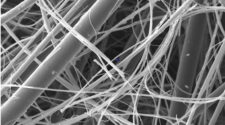
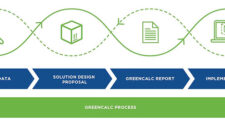

![Figure 1: Heat Exchanger Proventics GMBH.[22]](https://www.filtnews.com/wp-content/uploads/IFN_2_2024_crimpedmicrofiberyarns_Fig.-1-Heat-exchanger-225x125.jpg)

